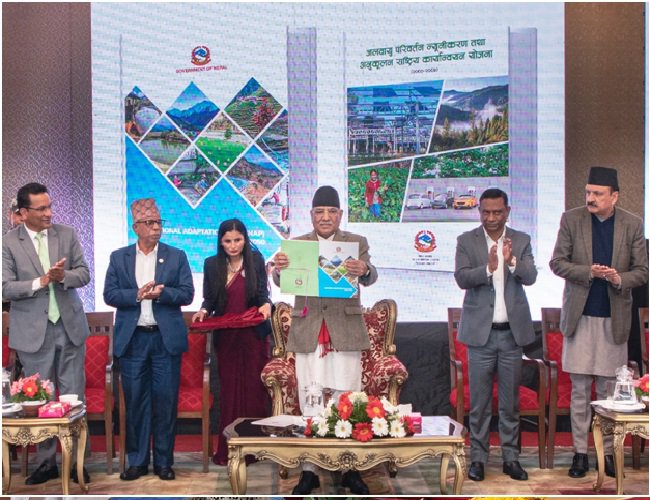
1.The Context
Nepal's National Adaptation Plan (NAP) process is broadly guided by the National Climate Change Policy (NCCP) 2019;Cancun decision 1/CP.16 in 2010: formulate and implement national adaptation plans to identify medium- and long-term adaptation needs; Durban decision 5/CP.17 in 2011: NAP initial guidelines and modalities for LDCs; and Paris Agreement Article 7 in 2015: Adaptation-para 9: Process to formulate and implement NAPs whichprovided the overarching policy guidance on building climate resilient systems. Its aim is set to create a climate resilient society by reducing the risks associated with climate change by integrating climate change into all levels of government and within thematic policy areas, strategies, development plans and programmes. The NCCP notably mentions that the implementation of all policies, strategies and plans related to climate change will be at the local level. The Nationally Determined Contribution (NDC) 2020 has stated that NAP process will be the medium of Adaptation Communications for Nepal.
Nepal NAP process, commenced in 2015, after traversing long distance, ups and downs, emotional fatigue, obstacles like Covid19, finally came up with the final NAP document (Nepal NAP 2021-2050) which was unveiled by the H'ble Prime Minister of Nepal on 21 November 2023. Nepal NAP has put forward the socio-economic and natural systems at high risks of climate change. It has outlined 64 adaptation interventions across 10 thematic and cross-cutting areas with a budget estimate of USD 47.4 billions (current price). The Nepal NAP aimed to achieve reduced climatic vulnerabilities and risks and further integrate Climate Change Adaptation (CCA) into development planning through:
1.Develop and enhance country capacity to promote CCA at systematic, institutional and individual levels; and help poor and vulnerable communities in adapting and building resilience to climate change impacts;
2.Contribute to the reduction of climate vulnerability by integrating CCA into existing and new polices, strategies and programmes;
3.Establish and/or strengthen a system to generate and share knowledge, experience, lessons learned, gaps and needs at international, national and sub-national levels to advance CCA for the benefit of the poor people and restoration of ecosystem; and
- Develop strategy to implement, monitor and communicate adaptation benefits at different levels.
- Nepal NAP Approaches
Nepal NAP innovatively espoused the global approaches: Country-driven, gender-responsive, participatory, fully transparent, consideration of vulnerable groups, communities and ecosystems, and should be based on and guided by the best available science and, as appropriate, traditional knowledge (Paris Agreement, Para 5). Based on the country experiences of National Adaptation Programme of Action (NAPA) and associated adaptation projects and programmes and inspired by the Constitution of Nepal, Periodic Development Plans and NCCP, Nepal adopted a national approach to the NAP process as:
- Establishing and functionalize thematic and cross-cutting working groups and Provincial Climate Change Coordination Committee (PC4) to coordinate multi-stakeholder thematic areas;
- Utilising existing coordination mechanisms;
- Building capacity and enhancing understanding on climate change adaptation;
- Building ownership and avoiding duplications on efforts;
- Promoting multi-stakeholder participation;
- Building on experiences of NAPA, LAPA, resilience and other good practices
- Ensuring gender-sensitivity and inclusiveness; 'LEAVE NO ONE BEHIND'
- Generating, utilising and sharing knowledge and good practices;
- Supplementing to 'development efforts' with integration of adaptation actions;
- Aligning with national policies and linking with recent initiatives (Sendai Framework and Sustainable Development Goals); and
- Synergising ecosystem-based and community-based adaptations.
In addition, the innovative points of departure of Nepal NAP are, promoting 'nature based solutions', 'build back better' and circular economy for generating multiplier and cascade effects of adaptation actions.
- Cruising the NAP Pathways
Nepal NAP process attempted to best use the available sciences coupled with indigenous and traditional knowledge. Climate change impacts assessments and analyses to inform medium- to long-term adaptation budgeting and planning were carried out at both national and sub-national levels.

Figure: Nepal Climate resilient planning pathways (NAP 2023)
Furthermore, the working groups established according to the NCCP 2019 for the NAP process produced a stocktaking report that reviewed available information on climate change and linkages to the established thematic areas and identified major stakeholders and key gaps and needs. The reports also included recommendations for the way forward. In addition, capacity gap assessments were produced for each theme and cross-cutting issues.
Sector-wise information on the vulnerability, impacts and adaptation were collected from the peer reviewed scientific articles, documents (mainly Third National Communications) and reports from sectoral ministries and departments. Information was obtained for different sectors including; agriculture, water resources, forests and biodiversity, public health, climate-induced disasters, human settlement and infrastructures, and gender and social inclusion.
The adaptation intervention ideas were collected from the local and provincial stakeholder process. Several rounds of 'shared learning dialogues' were conducted at provincial and federal level. Thematic conclaves were keys to finalise the sectoral adaptation interventions, budget and implementation strategies.
- Interim Achievements
Principally, the National Adaptation Plan (NAP) to climate change is a process that identifies country’s major climate risks and vulnerabilities, together with corresponding adaptation priorities and adaptation programme implementation strategies and modalities.The inclusion of climatic and non-climatic (e.g. socio-economic, cultural and bio-physical) variables in risk assessments and analyses of cost-benefit ratios of adaptation actions are crucial to inform and guide the national adaptation programmes and investments, including job creation, to ensure the long-term climate-resilience of the country and its economy. Furthermore, investing in climate-resilient infrastructure can be a source of economic growth and job creation. Through the NAP process, governments can also ensure the evidence of climate risks and vulnerabilities, based on future projections, are effectively communicated to the global and national stakeholders, private sector, allowing businesses to ensure their investments and prospects are climate-resilient. Through the development of cost-benefit analyses of adaptation measures, the NAP process can make the case that adaptation actions should be prioritized in the key economic sectors. It has also been suggested that NAP projects could define a set of criteria that would ensure recovery investments are climate-resilient.
One of the main focuses of the NAP process in Nepalis to catalyse funding for adaptation actions through integrating adaptation into national, subnational and local development planning and implementation courses. This strategy will seek to streamline conventional funding channels and also identifyadditionalfinancialresources to leverage adaptation actions in the NAP prescribed interventions. The challenge is to secure funding to implement adaptation strategies in the most vulnerable economic and social sectors in Nepal so the negative impacts of climate change including droughts, flooding, and soil erosion could be checked and the historical cultural and development achievements are safeguarded. The Nepal NAP will also secure coordination and collaborations among global and national state and non-state actors such as private sector, so that the climate resilient initiatives will reach to the systems at the highest risk with the mission of 'Putting the Last First'.
The NAP process, which is a continuous initiative, as achieved the following so far:
- Functional Province Climate Change Coordination Committee (PC4)
- National Adaptation Plan (2021-2050)
- Climate change finance strategy for Nepal (to be completed)
- Monitoring and review system for the NAP process institutionalised
- Institutionlised and functional working groups led and coordinated by the corresponding ministries at the federal level
- Enhanced capacity of all level of governments on climate change adaptation planning and implementation
- Step-by-step guidelines for Locally led Adaptation Plans implementation as a tool of downscaling NAP into local level
- Private sector engagement in climate change
- 5. Opportunities and way ahead
There are new entry points available for ministries and sub-national authorities to access climate finance and integrate adaptation across all sectors due to the availability of global basked funds (such as Green Climate Fund, Adaptation Fund, Global Environment Facility etc), as well as new climate-oriented structures and policies shifting from short- to long term adaptation needs. There are still additional steps needed to further the implementation of NAP, including: i) to systematically communicate climate risk, vulnerability knowledge and information available for informed decision making; ii) coordinate, clarify roles and responsibilities of provincial and local governments on NAPs and expand stakeholder engagement to ensure broad and inclusive participation, including mechanisms that ensure functional linkages between sub-national and federal governments; iii) identify resources for the implementation of the NAP, in terms of financial and human resources; and iv) establish a system to monitor and evaluate results of adaptation interventions, as well as establish the status of integration of climate change into development planning.
The country is in a 'ready to move' position for the 28th Conference of the Parties (CoP28) of the United Nations Framework Convention on Climate Change (UNFCCC). Nepal NAP is the strongest advocacy document among others. Nepal NAP has clearly speculated 64 adaptation interventions, periodic adaptation targets, sectoral ownership and a specified budget for immediate, medium- and long term interventions. Therefore this is a high time for the government to claim adaptation rights. It would be better to work with LDCs and other Low Income Countries to establish adaptation as a fundamental right of the must vulnerable.
Karki was a team leader of NAP. He can be reached at gyanendra.karki@gmail.com
















